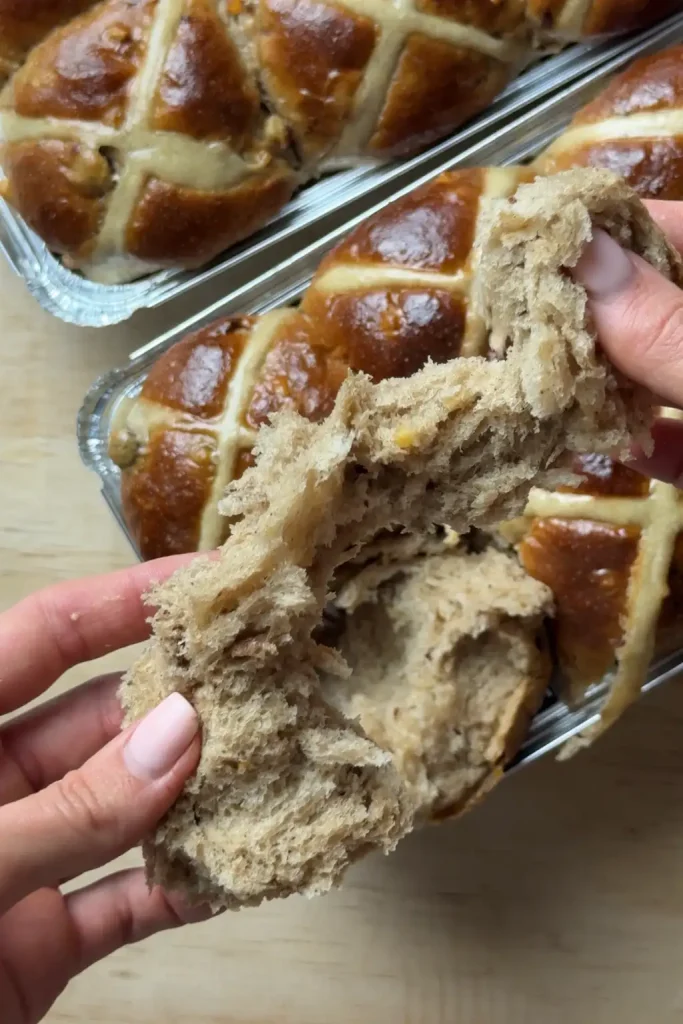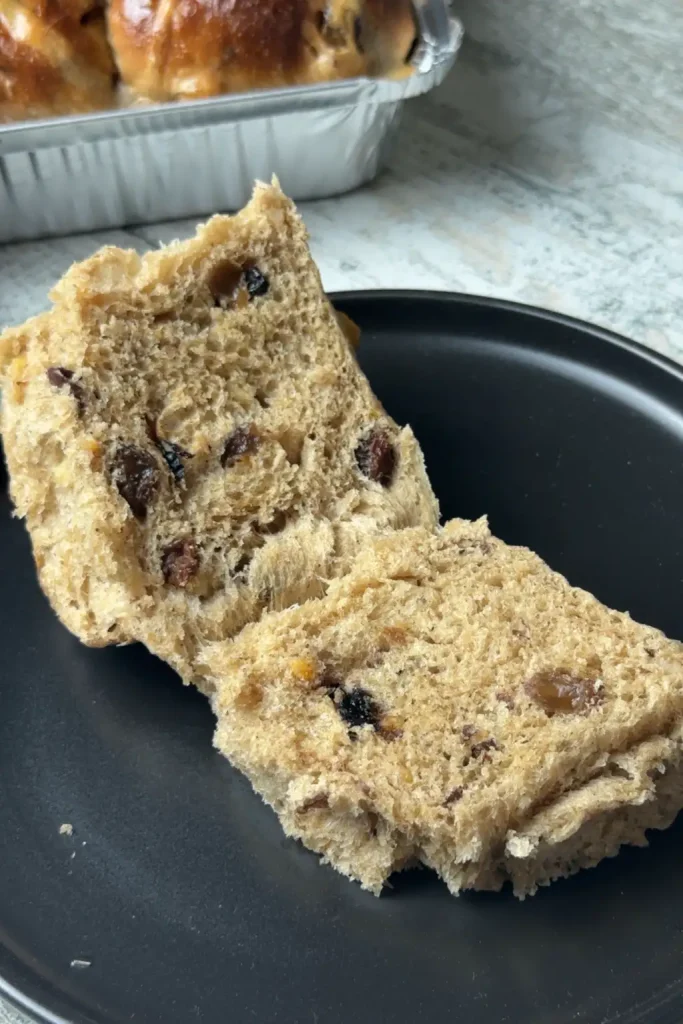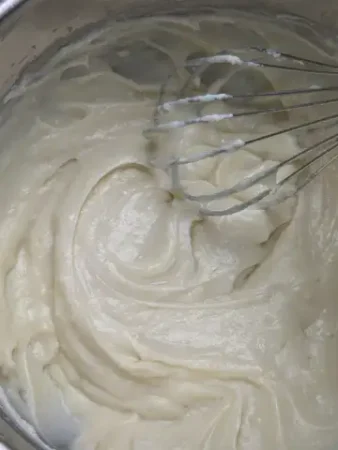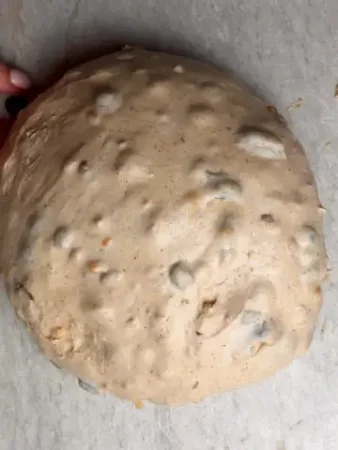These sourdough hot cross buns are the ultimate Easter bake, blending spiced fruitiness with a soft, enriched crumb.
Few things evoke the comfort of Easter quite like a tray of hot cross buns fresh from the oven. But these aren’t just any buns – they’re the product of seven rounds of testing, tweaking, and tasting to bring you the softest, fluffiest sourdough hot cross buns with the perfect balance of spice, fruit, and gentle sweetness. This recipe uses a tangzhong to lock in moisture, a unique rooibos tea soak for the fruit, and a mix of warm spices that make each bite taste like tradition with a twist.
The sourdough starter should be fresh, active, and mild – not tangy or acidic. A healthy starter is key to a soft, balanced flavour and a good rise.
Whether you’re a sourdough devotee or just up for a slow-ferment project, these buns are worth every minute. And if you’re in a pinch? There’s a yeast version too!

Why You’ll Love These Sourdough Hot Cross Buns
- Soft, pillowy texture thanks to the tangzhong method – stays fresh for up to a week!
- Complex, spiced flavour that deepens with fermentation
- Infused with rooibos-soaked fruit for a uniquely South African twist
- Versatile proofing options – sourdough or instant yeast
- No overly sticky glaze – just a subtle shine that enhances, not overwhelms

Plan Ahead: Suggested Timeline
To help you schedule this bake, here’s a rough timeline:
Dough
Evening Before:
- Feed your starter so it’s bubbly and active by morning.
- Prepare your levain (must be done the night before):
Mix 13g starter + 52g flour + 52g water (1:4:4 ratio). This yields about 130g; you’ll use 125g for the dough. - Soak the fruit:
Add your dried fruit and rooibos tea to a bowl, cover, and refrigerate overnight.
Morning (Day of Mixing):
- Make the tangzhong and let it cool.
- Mix and knead the dough.
- Incorporate butter, then fruit.
- Begin bulk fermentation.
Bulk Fermentation Note:
- The first rise can take up to 24 hours, depending on your ambient temperature.
- The ideal temperature is 20–25°C – warmer temps risk sourness. Cooler proofing is slower but results in better flavour.
Next Morning or Later:
- Once the dough is doubled, shape into buns.
- Proof until very puffy and delicate.
- Pipe crosses and bake.
- Glaze while warm.

Ingredients and Substitutions
Tangzhong:
- Bread flour – Helps lock in moisture and create a soft, fluffy texture.
- Full-cream milk – Adds richness and softness to the crumb.
Fruit Soak:
- Baker’s mix (sultanas, raisins, currants) – Brings chew and natural sweetness.
- Sub: any combination of chopped dried fruit you enjoy.
- Rooibos tea (hot) – Adds subtle, earthy depth and plumps the fruit.
- Sub: hot water or black tea.
- (Drain thoroughly before incorporating into the dough.)
Dough:
- All of the prepared tangzhong
- Bread flour – Provides strength and structure.
- Active sourdough starter – Ferments and lifts the dough.
- Sub: 2 tsp instant yeast + add 35g extra flour and omit the starter.
- Light brown sugar – Adds subtle caramel notes.
- White sugar – Balances sweetness.
- Full-cream milk – Moisture and richness.
- Large egg – For structure, richness, and softness.
- Salted butter (softened) – Flavours and enriches the dough.
- Sub: unsalted butter + 1g extra salt (for a total of 8g salt).
- Salt – Brings out all the flavours.
- Vanilla extract – Fragrant, sweet aroma.
Spices:
- Cinnamon
- Cloves
- Cardamom
- Allspice
- Mixed spice
- Black pepper – Adds gentle heat and depth.
- Ginger – A subtle warming note.
Add-ins:
- Mixed peel – A sweet/bitter citrus flavour that adds another layer of flavour.
Crosses:
- Flour – Base for the paste.
- Water – Hydrates the paste.
- Orange essence – Optional, but adds lovely fragrance and some flavour to the flour paste.
Glaze:
- Apricot jam – Classic for that glossy finish.
- Hot water – Loosens the jam for easy brushing.

Sourdough Hot Cross Buns
Ingredients
Tangzhong:
- 25 g bread flour
- 125 g full-cream milk
Fruit Soak:
- 190 g baker’s mix sultanas, raisins, currants
- 2 cups hot rooibos tea or hot water
Dough:
- 150 g tangzhong all of it you prepared
- 475 g bread flour
- 125 g active sourdough starter
- 50 g light brown sugar
- 50 g white sugar
- 150 g full-cream milk
- 1 large egg approx. 50g
- 60 g salted butter softened and cubed
- 7 g salt
- 1 tsp vanilla extract
Spices:
- 2 tsp ground cinnamon
- 1/2 tsp ground cloves
- 1/2 tsp ground cardamom
- 1 tsp ground allspice
- 1 tsp mixed spice
- 1/2 tsp ground black pepper
- 1/2 tsp ground ginger
Add-ins:
- 95 g mixed peel
Crosses:
- 45 g plain flour
- 45 g water
- 1/4 tsp orange essence optional
Glaze:
- 1 tbsp apricot jam
- 1-2 tbsp hot water
Instructions
Prepare the levain the night before
- Mix the starter, flour, and water. Cover loosely and ferment at room temperature for about 12 hours until just past peak (starting to fall again).
Soak the fruit
- Cover the dried fruit with hot rooibos tea. Refrigerate overnight. Drain well before using.
Make the tangzhong (next day)
- Whisk the bread flour and milk in a saucepan over medium heat until thick like pudding. Spread onto a plate, covered with cling film to prevent a skin forming.

Combine the wet ingredients
- In a large bowl or stand mixer, whisk together the cooled tangzhong, milk, egg, sugars, vanilla, and levain until smooth.
Add the dry ingredients
- Add flour, salt, and all spices. Mix until no dry bits remain. Cover and let rest for 20 minutes.
Develop gluten
- By hand: Slap and fold for 3–5 minutes until smoother. Rest 5–10 minutes. Perform a windowpane test and repeat if needed.
- By mixer: Knead on low speed for 5–8 minutes until the dough is smooth and passes a windowpane test.
Incorporate the butter
- By hand: Flatten the dough, smear butter over the top, fold, and knead until each cube is fully absorbed before adding more. If the dough resists you, let it rest for 5 minutes and come back to add the rest of the butter.
- By mixer: Add butter one cube at a time on low speed, letting each incorporate fully before the next.
Rest the dough
- Cover and let rest for 10 minutes.
Add the fruit
- By hand: Stretch the dough into a large rectangle. Sprinkle over the drained fruit and mixed peel. Fold like a letter and repeat once. Tuck in any stray fruit. Do some slap and folds to distribute the fruit properly. The gluten should form a thin skin over the fruits – that's how you'll know if it is properly developed.

- By mixer: Add fruit and peel directly to the bowl and mix on low for a few minutes until well-incorporated. The gluten should form a thin skin over the fruits – that's how you'll know if it is properly developed. Finish with a few gentle folds on the counter.
Bulk fermentation
- Transfer dough to a lightly oiled container. Cover and let rise at 20–25°C until doubled. Do not under-proof. This may take 8–24 hours depending on temperature.
Divide and shape
- Lightly flour the top of the dough and your counter.Turn dough out and divide into 14 equal portions (~103g each). Shape each into a tight ball by tucking in the corners and then rolling on the counter to create tension. The balls should be nice and tight. Arrange in a prepared baking tray with a little space between them.
Second proof
- Cover loosely with plastic and proof until buns are very puffy and doubled in size, 4–8 hours. Watch the dough, not the clock.
Pipe crosses
- Mix the flour paste and pipe crosses over the buns using a ziplock or piping bag with a snipped corner.
Bake
- Bake in a preheated oven on the middle rack at 180°C (350°F) for 20–25 minutes, or until golden and baked through. Mine baked for 25 minutes.
Glaze
- Warm the apricot jam and mix with hot water. Brush lightly over the hot buns for a shiny finish.
Notes
- Quick-cooling the tangzhong: To cool your tangzhong faster, spread it onto a small side plate and cover with cling film that touches the surface. This prevents a skin from forming and helps it cool in a fraction of the time.
-
Forgot to soften your butter?
- Cube the butter and leave it out while you mix and rest your dough — it’ll soften nicely at room temp.
- In a hurry? Microwave the cubed butter in 3-second bursts, checking between rounds until soft (not melted).
-
Using instant yeast instead of sourdough:
- Omit the sourdough starter.
- Add 2 tsp (7g) instant yeast directly to the flour.
- Increase the flour by 35g.
-
Adjust proofing times:
- First proof: 2–4 hours
- Second proof: 1–3 hours
- Still watch the dough, not the clock!
- Levain shortcut: Forgot to build your levain overnight? Use a 1:1:1 ratio (e.g. 45g starter + 45g flour + 45g water) and ferment at warm room temp until bubbly and doubled (approx. 4–6 hours).
- Avoiding sourness: Keep fermentation cool (20–25°C). Higher temps speed up fermentation and can lead to tangy buns, which we want to avoid.
- Checking if your buns are proofed: Gently press the side of a bun – it should leave a slight indentation and wobble slightly like a very delicate marshmallow. If they spring back quickly, they need more time.
- Mixing by hand tips: Butter and fruit incorporation is messier by hand, but doable. Don’t rush it. The butter will feel like it’s not going in – just keep kneading until each cube is absorbed. If fruit escapes during lamination, simply tuck it back under the dough.
- Spice flexibility: Adjust the spices to your liking. Add orange zest, nutmeg, or even a splash of rum to the fruit soak for a festive twist.
- Storage tips: Store cooled buns in an airtight container for up to 7 days. They stay so fresh for long because of the addition of the tangzhong. They also freeze beautifully.
Frequently Asked Questions
Can I make these sourdough hot cross buns with commercial yeast instead of sourdough?
Yes! If you’d prefer a quicker version, you can make these sourdough hot cross buns with instant yeast. Simply omit the starter and levain, add 2 tsp (7g) instant yeast, and increase the flour by 35g. Your proofing times will be much shorter — usually 2–4 hours for the first rise and 1–3 hours for the second.
Why are my sourdough hot cross buns sour?
Sourdough hot cross buns should be subtly sweet and gently spiced, not tangy. A sour flavour usually means the dough fermented too long or too warm. Make sure your starter is mild and healthy, and proof your dough between 20–25°C to avoid excess acidity.
How do I know when my sourdough hot cross buns are proofed and ready to bake?
Your buns should look puffed, airy, and slightly wobbly. Press one gently with your finger — if the dough springs back quickly, they need more time. If it leaves a slight indentation and feels delicate, they’re ready to go.
Can I shape sourdough hot cross buns and bake them the next day?
Yes! After shaping the buns, cover lightly with plastic and refrigerate overnight. The next day, let them return to room temperature, finish their final proof until very puffy, then pipe the crosses and bake as normal.
Do I have to use rooibos tea to soak the fruit for sourdough hot cross buns?
Not at all — rooibos is a lovely South African touch, but you can use hot water, black tea, or even spiced chai. The key is to hydrate the fruit so it’s juicy and plump in your buns.
What’s the best way to store sourdough hot cross buns?
Store cooled buns in an airtight container at room temperature for up to 7 days. To keep them longer, freeze them individually and reheat in a low oven when ready to eat.
Can I double this sourdough hot cross buns recipe?
Yes, you can double the batch — especially handy for big family gatherings. Just be mindful of your mixer’s capacity if you’re not mixing by hand, as this is an enriched dough and it can be a workout for smaller mixers.

